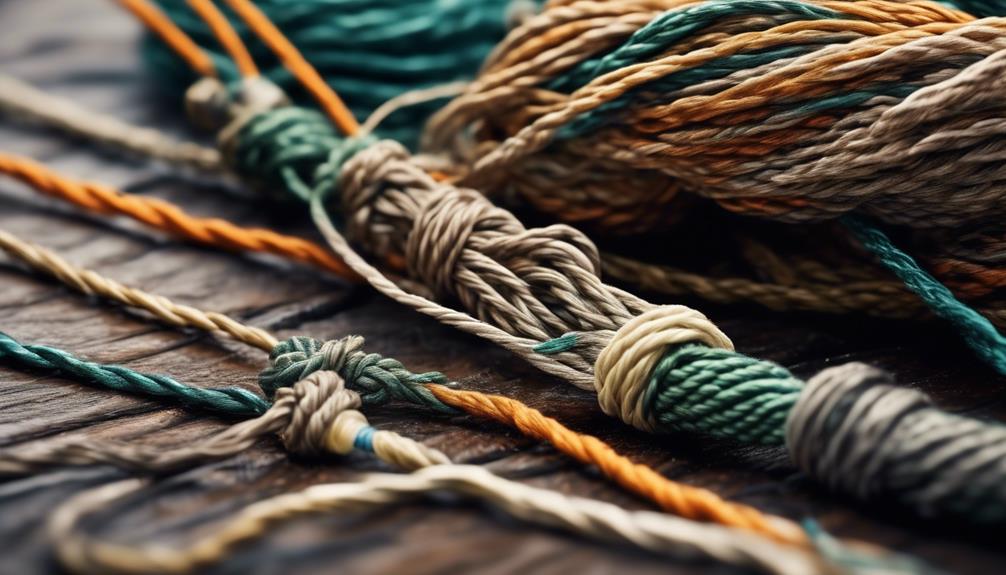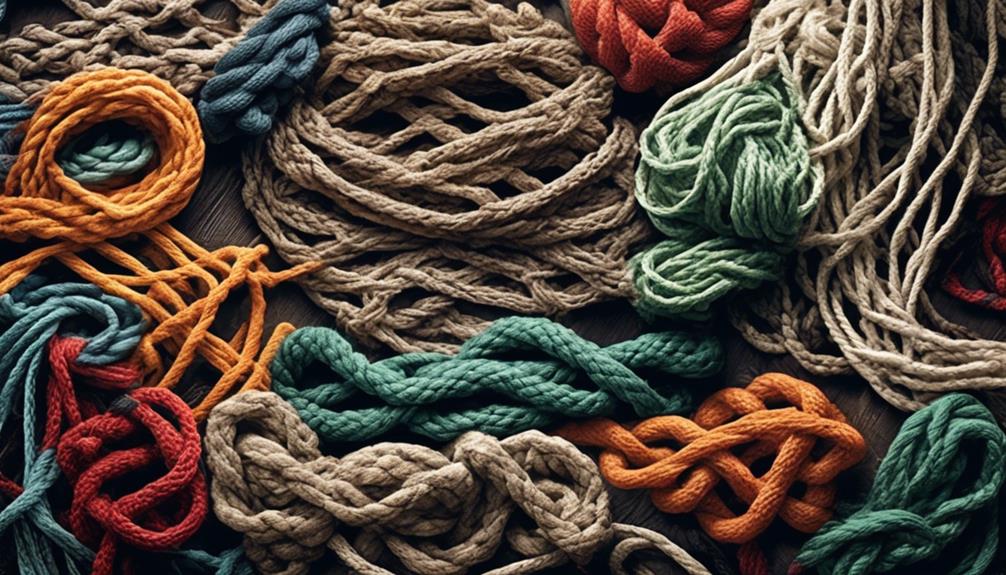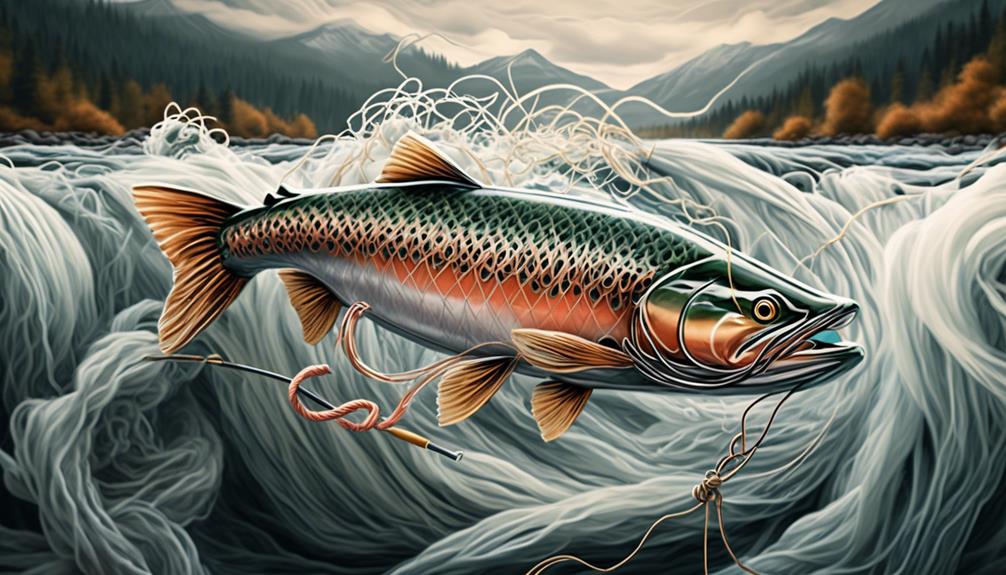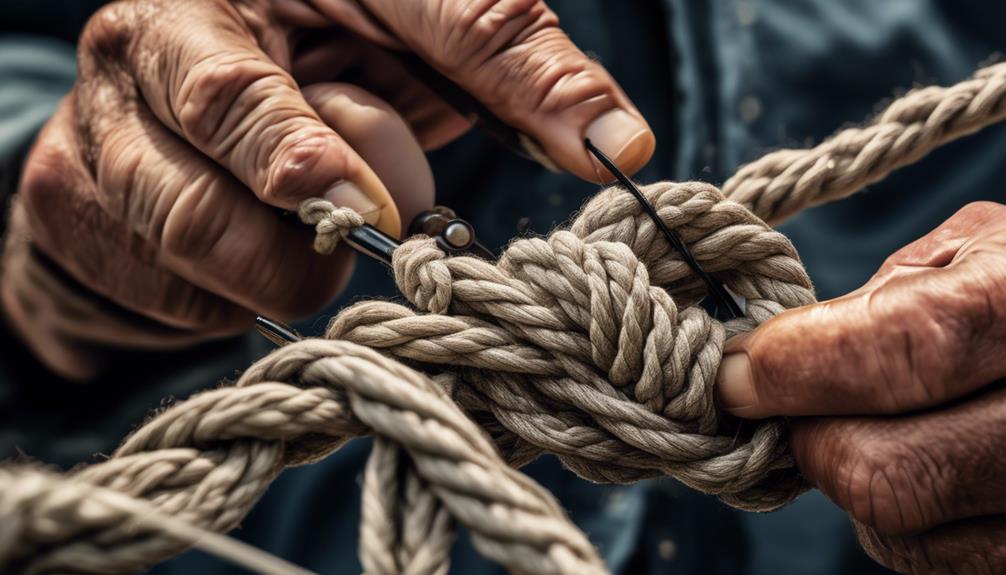When it comes to joining lines for fishing, finding the best knot is like uncovering a hidden treasure in the depths of the ocean. As an angler, you know the importance of a strong and reliable knot that can withstand the tug of a big catch.
But with so many different knots out there, it can be overwhelming to figure out which ones are truly the best for your specific needs.
Let's dive into the world of fishing knots and explore the top contenders that will elevate your fishing game to the next level.
Uni Knot
You'll find that the Uni Knot is a versatile and reliable knot for joining lines in fishing. Its strength lies in its ability to retain nearly 90% of the line's original strength, making it a trustworthy choice for securing different types of fishing lines. The Uni Knot's applications are numerous, as it can be used to attach hooks, swivels, and lures to the line, making it an essential knot for anglers of all levels.
One of the primary advantages of the Uni Knot is its remarkable strength. Whether you're using monofilament, fluorocarbon, or braided lines, this knot maintains a high level of strength, ensuring that it doesn't become the weakest link when reeling in a big catch. Its reliability in maintaining line strength gives anglers confidence when tackling larger, stronger fish.
The Uni Knot's applications extend beyond just connecting the main line to terminal tackle. It's also ideal for joining two lines together, making it useful for creating leader systems or attaching backing to the main line on a reel. Furthermore, it can be used to secure the tag end of the line after tying other knots, adding an extra layer of security to your connections.
Blood Knot
The Blood Knot is a popular choice for anglers when joining two lines together due to its strong and reliable hold, making it an essential knot for creating leader systems or connecting backing to the main line on a reel. When tying a Blood Knot, it's crucial to ensure that the wraps are neatly and evenly wound to maximize its strength. This knot is particularly effective for connecting lines of similar diameters, as it distributes pressure evenly across the knot, minimizing the risk of breakage.
The Blood Knot strength lies in its ability to maintain a high percentage of the lines' original strength when tied correctly. This makes it a favored choice for scenarios where maintaining line integrity is crucial, such as when targeting larger or hard-fighting fish. Additionally, the Blood Knot's design allows for a smooth passage through rod guides, reducing the likelihood of snags and providing a more seamless casting experience.
To execute the Blood Knot tying technique, start by overlapping the ends of the two lines to be joined. Then, create five to seven wraps around both lines, ensuring that the wraps are neatly aligned without overlapping. Finally, thread the tag end through the gap between the lines and tighten the knot by pulling both main lines in opposite directions. Once secured, trim the tag ends closely to the knot to prevent any interference with the line's movement.
With practice, mastering the Blood Knot can significantly enhance an angler's ability to create strong and reliable line connections.
Double Uni Knot
For a strong and versatile knot to join lines, the Double Uni Knot is an excellent choice for anglers of all skill levels. This knot is known for its strength and reliability, making it a popular choice for connecting lines of different materials or diameters.
The Double Uni Knot strength is impressive, as it retains a significant amount of the lines' original strength when tied correctly. One of the main advantages of the Double Uni Knot is its ability to maintain a high breaking strength, which is crucial when targeting large or powerful fish species. Additionally, this knot is relatively easy to tie, requiring minimal equipment and no specialized tools.
Joining lines with the Double Uni Knot is a straightforward process. Start by overlapping the ends of the two lines you want to join. Then, form a loop with one end and make several wraps around both lines and through the loop. Repeat this process with the other line, ensuring the wraps are similar in number. Finally, pull the standing lines in opposite directions to slide the knots together, and trim the tag ends. When tying the Double Uni Knot, it's essential to moisten the lines before pulling the knot tight to reduce friction and prevent damage to the lines.
Despite its strength and versatility, the Double Uni Knot does have some disadvantages. It can be bulkier compared to other knots, potentially affecting its ability to pass through rod guides smoothly. Additionally, it may not be the best choice for very fine lines due to its bulkiness. However, with practice and attention to detail, the Double Uni Knot can be a valuable addition to any angler's repertoire.
Surgeon's Knot
To securely join lines, consider using the Surgeon's Knot, a simple yet effective knot for connecting fishing lines. The tying technique for the Surgeon's Knot involves overlapping the ends of the lines to be joined and then tying a double overhand knot with the doubled lines. This creates a secure connection that's particularly useful when dealing with monofilament lines of varying diameters. It's a quick and easy knot to tie, making it a popular choice among anglers.
In terms of strength comparison, the Surgeon's Knot is often compared favorably to other line joining knots. When tied correctly, it retains a significant amount of the lines' original strength, allowing for reliable performance when battling strong fish or fishing in challenging conditions.
Common applications of the Surgeon's Knot include joining a leader to the main line, attaching tippet to a leader in fly fishing, and connecting two lines of different diameters. Its simplicity and effectiveness make it a versatile knot for various fishing scenarios.
In addition to its primary use in fishing, the Surgeon's Knot has alternative applications in everyday situations. It can be employed in crafting and sewing to securely join different types of threads or lines, making it a handy knot to know beyond the realm of fishing.
Albright Knot
Consider using the Albright Knot for creating a strong and smooth connection between lines of different diameters, especially when fishing in saltwater or freshwater environments. The Albright Knot is a versatile and reliable knot that has several advantages for anglers.
Here's why it's worth considering:
- Albright Knot Strength: The Albright Knot is known for its exceptional strength. When tied correctly, it retains a significant amount of the lines' original breaking strength, making it a dependable choice for joining different lines, such as monofilament to braided lines or leader to mainline connections.
- Albright Knot Applications: This knot is particularly useful for creating a secure connection between lines of varying diameters. It's commonly used for attaching a leader to the main fishing line, allowing for a seamless transition between lines of different strengths and thicknesses.
- Albright Knot vs Other Line Joining Knots: Compared to other line joining knots like the Blood Knot or Double Uni Knot, the Albright Knot has the advantage of being more streamlined and smooth. This can be beneficial when casting, as it reduces the likelihood of snagging on the rod guides and provides a more aerodynamic connection.
When fishing in situations where a strong and reliable connection between different lines is crucial, the Albright Knot is a go-to choice for many anglers due to its strength, versatility, and smooth profile.
Nail Knot
The Nail Knot, like the Albright Knot, is an essential tool for joining lines effectively and securely, particularly in fly fishing applications. Its design allows for a smooth and streamlined connection, making it ideal for attaching leaders to fly lines or for joining lines of different diameters. One of the key advantages of the nail knot is its strength and reliability. When tied correctly, it creates a secure connection that maintains a high percentage of the line's original strength, crucial for landing those big catches.
When tying the nail knot, it's important to consider the compatibility of the fishing lines being joined. This knot works best with monofilament or fluorocarbon lines, and it's particularly popular in fly fishing due to its effectiveness with the lighter lines typically used in this style of fishing. When tying the nail knot, using a tool like a nail knot tool or a small-diameter tube can make the process much easier. These tools help in forming the wraps and ensuring the knot is snug and secure.
Some common mistakes to avoid when tying the nail knot include insufficient wraps, uneven wraps, and not properly lubricating the knot before tightening. Insufficient wraps can lead to a weaker connection, while uneven wraps can cause the knot to slip or fail. Lubricating the knot before tightening is essential to prevent damage to the line and ensure a tight, secure knot.
Mastering the nail knot takes practice, but once perfected, it becomes a valuable skill for any angler.
Slim Beauty Knot
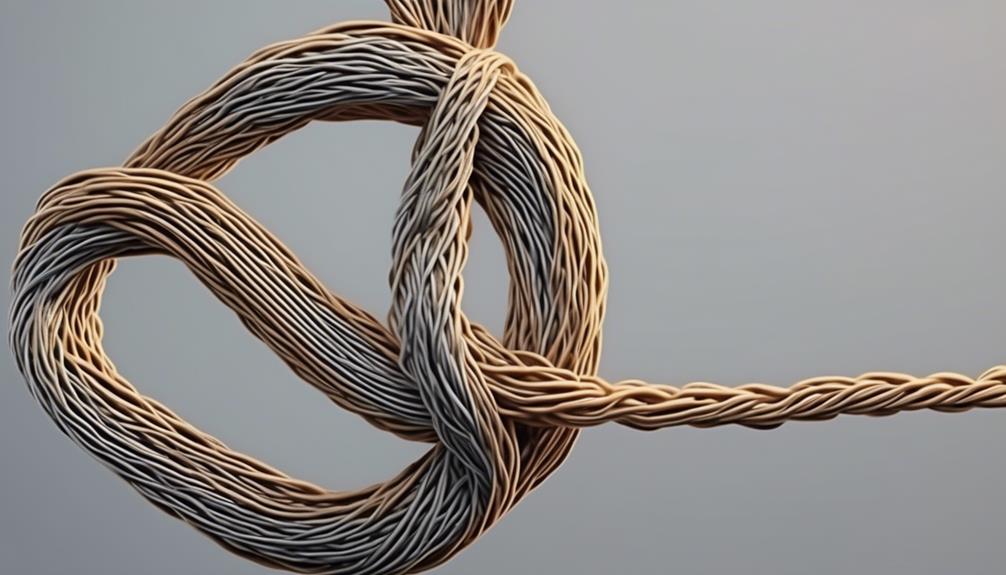
When learning to tie the Slim Beauty Knot, practice and patience will be key to mastering this versatile and reliable fishing knot. The Slim Beauty Knot is popular among anglers for its strength and sleek profile, making it an ideal choice for joining lines of different diameters.
Here's a step-by-step tutorial to help you become proficient in tying the Slim Beauty Knot:
- Step 1: Overlap the two lines you want to join, forming a loop with the tag end of the heavier line crossing over the lighter line.
- Step 2: Take the tag end of the heavier line and make 15 wraps around both lines and through the loop.
- Step 3: Moisten the knot and pull the standing lines in opposite directions to tighten the wraps, ensuring the coils are neatly stacked together.
Advantages of the Slim Beauty Knot:
- It maintains a relatively high breaking strength, which is crucial for landing large fish.
- The knot has a slim profile, allowing it to pass through rod guides smoothly without impairing casting performance.
- It's versatile and can be used to join lines of different materials and diameters with minimal bulk.
Disadvantages of the Slim Beauty Knot:
- The tying process can be intricate and may require some practice to perfect.
- In some cases, the knot may slip if not tied correctly, so attention to detail is essential for reliable performance.
FG Knot
Mastering the Slim Beauty Knot prepares you to tackle the FG Knot, another favored option for joining lines due to its exceptional strength and minimal profile. The FG Knot, also known as the Fine Grip Knot, offers several benefits that make it a popular choice among anglers. Its slim and compact design allows it to pass through rod guides with ease, minimizing interference during casting. Additionally, the FG Knot boasts remarkable strength, often nearing 100% line strength, making it ideal for handling powerful and aggressive fish species.
When it comes to tying techniques, the FG Knot may seem daunting at first, but with practice, it becomes more manageable. The key lies in maintaining consistent tension and ensuring that the wraps are neatly aligned. Many anglers utilize a tool such as a rubber band or specialized FG Knot braiding tool to facilitate the tying process. With proper technique and attention to detail, the FG Knot can be reliably secured, providing a seamless connection between lines.
In comparison to other joining knots like the Albright Knot or Improved Blood Knot, the FG Knot excels in terms of strength and profile. Its slim and smooth profile allows for smoother casting and reduced snagging, particularly when using leaders. While other knots may be easier to tie initially, the FG Knot's superior performance in strength and durability makes it a worthy investment of time and effort to master.
Frequently Asked Questions
What Are the Best Types of Fishing Lines to Use With Each of These Knots?
When selecting the best fishing lines to use with each knot, consider the strength and diameter of the line. Matching knots with the appropriate fishing line is crucial for ensuring a secure connection.
Different knots work best with specific types of fishing lines, so it's important to consider fishing line compatibility when making your selection. Pay attention to knot selection and ensure it complements the characteristics of the fishing line you're using.
Can These Knots Be Used for Joining Lines of Different Diameters?
Yes, these knots can be used for joining lines of different diameters. Knot strength is crucial when combining lines with variations in diameter. Ensure to follow fishing knot tutorials to achieve the best results.
Additionally, it's essential to consider line compatibility when dealing with line diameter differences. By selecting the appropriate fishing knot and understanding line compatibility, you can effectively join lines of different diameters for a successful fishing experience.
Are There Any Specific Types of Fishing Techniques or Conditions Where These Knots Are Particularly Effective?
In specific fishing techniques and conditions, some knots are particularly effective for joining lines. They offer advantages like strength and reliability, but may have limitations in certain situations.
Alternatives exist, but these effective knots are well-suited for scenarios like deep-sea fishing or heavy lure casting.
Understanding their strengths and weaknesses will help you choose the right knot for your fishing needs.
Can These Knots Be Used for Joining Braided Lines to Monofilament or Fluorocarbon Lines?
Yes, you can use these knots for joining braided lines to monofilament or fluorocarbon lines. Knot strength is crucial, and these knots are known for their reliability.
When it comes to line compatibility, these knots are versatile and can be used for various fishing techniques. You can find fishing knot tutorials online that demonstrate different line joining techniques, including those for braided line to fluorocarbon line connections.
Are There Any Alternative or Lesser-Known Knots That Can Be Used for Joining Fishing Lines?
Looking for alternative knots for joining fishing lines, especially for different diameters?
When it comes to braided and monofilament lines, there are lesser-known options that can be handy for various fishing techniques. These knots can provide reliable strength and durability for joining lines of different types.
Exploring these alternative knots can expand your fishing knot repertoire and give you more flexibility in your fishing endeavors.
Conclusion
So there you have it – a variety of fishing knots for joining lines that will help you secure your tackle and land more fish.
Whether you're tying the Uni Knot, Blood Knot, or any other knot on the list, practice makes perfect. Experiment with different knots to find the one that works best for you and your fishing style.
With these knots in your arsenal, you'll be ready for any fishing adventure that comes your way.
Happy fishing!
